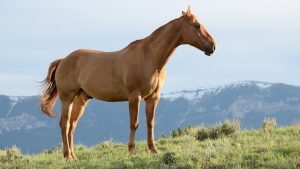Is your horse pregnant? If you’re an experienced breeder, you can probably tell if it’s in foal, but for first-timers, it’s hard to know if it is under gestation. Pregnancy in horses, also known as gestation, is a crucial and fascinating period in the life of these majestic animals. Answering this question is essential because if it shows signs of pregnancy, you must provide extra care for the mare and the foal inside.
My time on the horse breeding farm was not just about observing the miracle of birth but also about learning crucial lessons for owning a horse. Bella’s pregnancy journey taught me that owning a horse requires meticulous attention to their health and well-being, much like the intensive care we provided as she progressed through her third trimester. Monitoring Bella’s nutrition and behavior underscored the importance of proper management and veterinary oversight in ensuring a healthy pregnancy, which directly translates to responsible horse ownership. This experience underscored the importance of preparation and attentiveness during equine pregnancy. According to the American Association of Equine Practitioners (AAEP), proper nutrition during pregnancy is crucial for the health of both the mare and the developing foal. They recommend tailored feeding plans and regular veterinary check-ups to monitor the mare’s condition and address potential complications early on (AAEP, 2023).
In this article, we will discuss the essential things you need to know regarding pregnancy in horses. We will elaborate on the whole process, from the techniques used to determine if your equine is pregnant to the phases of gestation. Understanding the foaling process and what happens in each stage will help you be free from undue stress and worry.
How to Tell if Your Mare is in Foal
There are many ways to determine if your equine pet is pregnant.
- Mare Immunological Pregnancy (MIP) Test
This type of test can detect equine chorionic gonadotropin levels in the serum of the increase between the 40th and 120th day of gestation. It has 95% accuracy, is convenient to use, and is inexpensive, which is why it is widely used.
- Transrectal Ultrasonography or ultrasound
This test is also an accurate means of determining if your horse carries twins or has double ovulation and is commonly used between days 12 and 15 of gestation. Twin pregnancy is dangerous for the equines since it can damage the reproductive tract of the horse, and it puts the mare and the foals at risk. It can result in the death of the mare. And that’s where ultrasound comes in. It helps to manage pregnancy reduction to a single foal and ensure they’re in good condition. By day 30, the foal’s fetal heartbeat will be visible via ultrasound.
- Test on plasma and milk progesterone levels
This method is useful in lactating mares as early as the 16th day of pregnancy since they are sensitive to elevation and are 90% accurate.
Average Gestation Period of Horses
The average gestation of an equine is 340 days or 11 months, but it may range from 320 to 370 days. Mares who give birth after 399 days are said to produce a healthy foal. But if the foal is delivered before 315 days, it will be considered premature, and if born before 300 days, it may not survive. Usually, the breeding takes place during summer, so the foals will be born the next year in spring or early summer when the weather is mild and abundant pasture is present. Now, let’s look at the stages of a mare’s gestation and the journey before giving birth.
Stages of Mare Gestation
In a mare’s first 100 days of pregnancy, some physical changes will show and become noticeable. Her uterus will change in shape, the uterine horn will become firm and tubular, her cervix will grow firm and contracted, and her uterine wall will thinner at the site of the implanted embryo. She’ll gain more appetite at this stage but might sometimes become moody. Many vets recommend having a second pregnancy test when she enters the middle stage of her pregnancy because one in every three mares lose their babies during the early years, and the owner may not notice it.
On the mare’s 150th day of pregnancy, the foal weighs about 2 lbs. And its extremities will be fully developed. On the 180th day, it’ll gain more weight until it weighs 10 pounds, and the whiskers and eyelids capable of blinking will grow.
By the 250th day of gestation, you will notice that your mare’s abdominal weight gains and the foal will begin gaining 1 lb daily. And by the 300th day, the lungs will be developing, and the body will be getting ready for life outside her mother’s belly.
This time, the mare’s udder will slightly expand and start producing a sticky yellow substance that will turn into milk about two weeks before the delivery. As the time for giving birth comes closer, the abdomen will become heavier; her vulva will relax and lengthen. On the 315th day, you should observe it daily and be prepared for foaling.
Stages of a Mare’s Labor
According to Colorado State University, a mare has three stages of foaling.
First Stage
In the early stage of labor, the mare may act tensed and restless, going around her stall and paddock, taking small amounts of hay, and swishing the tail. She may lie down and get up frequently and show symptoms like mild colic, such as abdominal discomfort and sweating along her neck and flanks. This stage is the longest and may take 1 to 4 hours. Your horse may not exhibit all the signs mentioned above, but most horses will have a change in behavior in this stage.
Second Stage
This stage takes 15 to 20 minutes to complete, and it starts when the “water” breaks as it stands up and ends when the foal has been born. The water breaking is due to the rupture of the chorioallantoic membrane, which bursts before it is pushed to the cervix and then releases the allantoic fluid.
The contraction in the uterus now begins, and as the mare lays down, the feet and head become visible within 15 minutes. Call your veterinarian if it does not appear after 20-30 minutes because your mare may be having trouble.
In a normal delivery, the foal’s front feet will emerge first, with its sole pointing downward and muzzle positioned at the level of its knees. After delivery, if the amniotic sack – a thin and transparent whitish membrane covering the foal does not rupture, it is removed from its face and head. That would help the newborn to breathe. Then, the mare will rest for a few minutes and allow the blood to follow from her body to the foal before the umbilical cord detaches. Please do not cut the cord because it might cause bleeding, so let it break naturally when she stands up.
Look out for “red bag” – an alarming situation where a velvety-red membrane emerges from the vulva, which causes complications. It’s a sign that the placenta has detached without bursting.
Third Stage
The placenta will come out in the final stage, usually a few minutes to an hour after the foal’s delivery. Colic-like symptoms like contractions will continue even if the placenta has been expelled.
If the placenta does not come out even after 2 hours, it must be retained, causing complications. So, if this happens, call your vet. It’s also essential for the foal to nurse within twenty-four hours after birth. That is because colostrum, or first milk containing antibodies, helps protect the foal from diseases until its immune system fully develops. It can only benefit within a short period.
It may be a long journey before the mare gives birth, and the labor might seem challenging, but the good news is most horses often deliver without any complications. That’s if your horse has had good feeding and proper management during pregnancy. Here are some tips to help you ensure your pet is healthy while carrying the foal and have a smooth labor.
Feeding and Management for Pregnant Horses
During a mare’s pregnancy, there would be several necessary adjustments regarding nutrition and management. Your pregnant horse needs the best quality pasture, hay, salt, and essential minerals. You may also need to avoid feeding your horse with fescue grass infected with the fungal endophyte acremonium coenophialum. It causes prolonged gestation, decreased fertility, reduced foal viability, and other serious problems. You may let her graze elsewhere, free from fescues and pasture bullies who might injure her because it can make it difficult for her to deliver the foal.
Your mare shouldn’t receive any vaccination or deworming in the first three months of gestation. These medications are necessary for the pregnancy, but they can hinder the development of the fetus. You also need to invest in getting your horse checked regularly by a veterinarian. It may cost you a lot of money, but it is smaller than raising a new foal or losing the mare and baby it carries. Your vets can give you the best advice about what’s safe for your horse throughout the pregnancy.
Pregnancy in horses is a remarkable journey that requires careful attention to detail and proactive veterinary care. By understanding the stages of pregnancy, preparing appropriately, and providing attentive postnatal care, you can support the health and well-being of both the mare and her foal. Whether you’re a first-time breeder or an experienced equestrian, the bond forged during this period is both rewarding and essential for the future of your equine companions.





